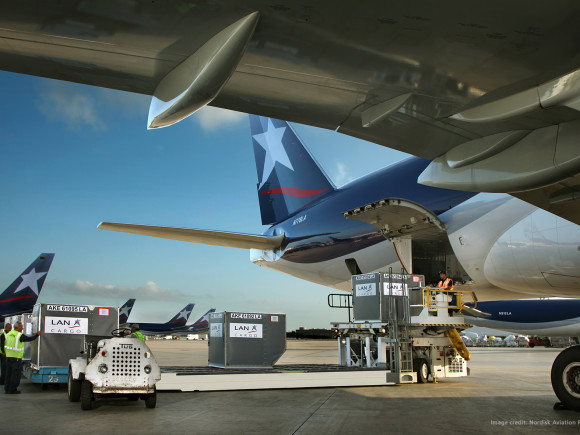Fresh products and at their destination in the shortest time possible, are the most important attributes to be met by the cargo affiliates of LATAM Airlines Group, among these, LAN CARGO, transporting one of the highlights of perishable cargo business: Chilean salmon.
LATAM Airlines Group and its cargo affiliates transport salmon to over 30 countries, the main destinations being the United States and Brazil.
The journey begins in southern Chile, near Puerto Montt and Chiloé, ending at tables in different countries around the world.
Learn more about the production and transportation of this valued product.
Chile, specifically the south of the country, has its own characteristics that favor large scale and high quality salmon production. Its natural resources deliver optimal hydrographic conditions, adequate water temperatures and reverse seasonality compared to other producing areas. The climate and natural conditions are exceptional for salmon farming, possessing great advantages originated in the temperature, pH, purity and oxygen levels of its waters.
The Chilean salmon grows in the waters of the South Pacific, regarded as one of the purest and most uncontaminated in the world. The influence of the Humboldt Current cools its waters generating unique conditions for marine life, hosting a variety of species.
Yearly, LATAM Airlines Group and its cargo affiliates transport over 50,000 tons of salmon to over 30 countries, the main destinations being the United States and Brazil. In the latter case, the product represents 54 % of the cargo volume transported from Chile to Brazil.
It all starts during autumn in the southern hemisphere with the fertilization, a process that is performed at a temperature of 50°F (10°C). Subsequently, the incubation process takes place in freshwater until they complete their development. Occurring in semi -light conditions or darkness, this step is very delicate requiring clean, well-oxygenated waters.
After incubation, the juvenile salmon swims freely and starts feeding. In this stage its growth rapidly increases because of its nutritional requirements. Then in the spring of the following year, the salmon’s color turn silver, green and brownish and its behavior changes to one of shoal.
The fish are transferred to the fattening center until, after 12 and 18 months, reach an average of 9.9 pounds (4.5 kilos) in weight. After this begins the harvest in which the fish are separated by size and those to be taken are selected.
After that, they are taken to the processing plant where the various products to be exported according to destination start to take shape.
After that, they are taken to the processing plant where the various products to be exported according to destination start to take shape.
Salmon production cycle is completed and a new phase begins: the transportation to different markets. For this, the producers leave the salmon in the hands of the LAN CARGO offices in Santiago, who are responsible for transporting it through the cargo network in aircrafts to different destinations. This step of the process is very important because the product must be handled and conditioned in a way that does not lose temperature or alter the cold chain. Thus, the LAN CARGO team and its related companies, test their expertise in managing complex load.
After this rigorous process of production and transportation, the Chilean salmon reaches various households, stores and restaurants in the world, with the freshness and taste demanded by customers. Among the most popular preparations are sushi, carpaccio and ceviche in addition to more traditional oven or grilled recipes.
During 2013, LATAM Airlines Group and its affiliates transported over 55,000 tons of salmon, of which over 50,000 went to the United States and 2,000 to Brazil. The rest were transported within Latin America, Europe and Oceania.
